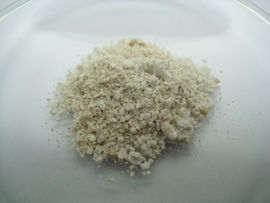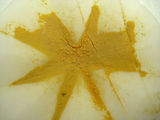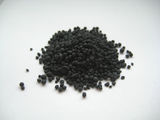Difference between revisions of "Calcium cyanamide"
Diachrynic (Talk | contribs) |
|||
| (8 intermediate revisions by 2 users not shown) | |||
| Line 11: | Line 11: | ||
| ImageAlt = | | ImageAlt = | ||
| ImageName = | | ImageName = | ||
| + | | ImageCaption = Freshly made calcium cyanamide | ||
| ImageFile1 = | | ImageFile1 = | ||
| ImageSize1 = | | ImageSize1 = | ||
| Line 112: | Line 113: | ||
==Properties== | ==Properties== | ||
===Chemical=== | ===Chemical=== | ||
| − | Hydrolysis of CaCN<sub>2</sub> will yield [[cyanamide]], as well as ammonia. | + | Hydrolysis of CaCN<sub>2</sub> will yield [[cyanamide]], as well as [[ammonia]]. |
: CaCN<sub>2</sub> + H<sub>2</sub>O + CO<sub>2</sub> → CaCO<sub>3</sub> + H<sub>2</sub>NCN | : CaCN<sub>2</sub> + H<sub>2</sub>O + CO<sub>2</sub> → CaCO<sub>3</sub> + H<sub>2</sub>NCN | ||
: CaCN<sub>2</sub> + 3 H<sub>2</sub>O → 2 NH<sub>3</sub> + CaCO<sub>3</sub> | : CaCN<sub>2</sub> + 3 H<sub>2</sub>O → 2 NH<sub>3</sub> + CaCO<sub>3</sub> | ||
| + | |||
| + | At high pH, cyanamide converts to [[cyanoguanidine]] (dicyandiamide). | ||
Fusing calcium cyanamide with sodium carbonate will give sodium cyanide. | Fusing calcium cyanamide with sodium carbonate will give sodium cyanide. | ||
: CaCN<sub>2</sub> + Na<sub>2</sub>CO<sub>3</sub> + 2C → 2 NaCN + CaO + 2 CO | : CaCN<sub>2</sub> + Na<sub>2</sub>CO<sub>3</sub> + 2C → 2 NaCN + CaO + 2 CO | ||
| + | |||
| + | Fusing calcium cyanamide with [[ammonium nitrate]] at high temperatures will give [[guanidinium nitrate]].<ref>https://cdnsciencepub.com/doi/pdf/10.1139/v58-211</ref> Although some old literature data indicates that the reaction can also be done in an aq. solution, it's been shown that the presence of water may lead to the formation of other side products.<ref>https://www.freepatentsonline.com/2431301.pdf</ref> | ||
===Physical=== | ===Physical=== | ||
| Line 124: | Line 129: | ||
==Availability== | ==Availability== | ||
| − | Calcium cyanamide is sold as fertilizer. In some places it's hard to find, as the compounds readily hydrolyzes in the presence of moisture, and water-sensitive materials are generally not sold in most stores due to safety. | + | Calcium cyanamide is sold as fertilizer, usually in the form of black pellets, which contain up to 50% CaCN<sub>2</sub> by mass. In some places it's hard to find, as the compounds readily hydrolyzes in the presence of moisture, and water-sensitive materials are generally not sold in most stores due to safety. |
It can also be bought from chemical suppliers. | It can also be bought from chemical suppliers. | ||
| Line 131: | Line 136: | ||
A common route to calcium cyanamide involves heating a mixture of [[calcium oxide]] and [[urea]] at 120-350 °C which gives calcium cyanate, followed by calcination at 7-900 °C to give calcium cyanamide.<ref>https://www.youtube.com/watch?v=S-SOjfZ_yS4</ref> | A common route to calcium cyanamide involves heating a mixture of [[calcium oxide]] and [[urea]] at 120-350 °C which gives calcium cyanate, followed by calcination at 7-900 °C to give calcium cyanamide.<ref>https://www.youtube.com/watch?v=S-SOjfZ_yS4</ref> | ||
| − | :3 CO(NH<sub>2</sub>)<sub>2</sub> → 3 HOCN + NH<sub>3</sub> | + | : 3 CO(NH<sub>2</sub>)<sub>2</sub> → 3 HOCN + NH<sub>3</sub> |
| − | :CaO + 2 HOCN → Ca(OCN)<sub>2</sub> + H<sub>2</sub>O | + | : CaO + 2 HOCN → Ca(OCN)<sub>2</sub> + H<sub>2</sub>O |
| − | :Ca(OCN)<sub>2</sub> → CaCN<sub>2</sub> + CO<sub>2</sub> | + | : Ca(OCN)<sub>2</sub> → CaCN<sub>2</sub> + CO<sub>2</sub> |
| + | |||
| + | Calcium cyanamide is obtained industrially by heating [[calcium carbide]] powder at 1,000 °C, usually in an electric furnace, while injecting [[nitrogen]] gas over the hot carbide, which is recirculated. The reaction takes several hours for completion. The reaction produces carbon and is the reason commercial calcium cyanamide fertilizer is usually black in color. | ||
| − | + | : CaC<sub>2</sub> + N<sub>2</sub> → Ca(CN)<sub>2</sub> → CaCN<sub>2</sub> + C | |
Another route involves heating calcium cyanide with nitrogen gas at 600 °C for at least one hour.<ref>Franck, H.; Heimann, H.; Angewandte Chemie; vol. 44; (1931); p. 372 - 378</ref> | Another route involves heating calcium cyanide with nitrogen gas at 600 °C for at least one hour.<ref>Franck, H.; Heimann, H.; Angewandte Chemie; vol. 44; (1931); p. 372 - 378</ref> | ||
| Line 143: | Line 150: | ||
Reacting [[ammonia]] with [[calcium carbonate]] above 600 °C is another route.<ref>Franklin; Journal of the American Chemical Society; vol. 44; (1922); p. 504</ref><ref>Patent; Caro; Frank; DE467479; Fortschr. Teerfarbenfabr. Verw. Industriezweige; vol. 16; p. 283</ref> | Reacting [[ammonia]] with [[calcium carbonate]] above 600 °C is another route.<ref>Franklin; Journal of the American Chemical Society; vol. 44; (1922); p. 504</ref><ref>Patent; Caro; Frank; DE467479; Fortschr. Teerfarbenfabr. Verw. Industriezweige; vol. 16; p. 283</ref> | ||
| − | Since calcium cyanamide reacts with oxygen at high temperatures, all of these routes must be done in | + | Since calcium cyanamide reacts with oxygen at high temperatures, all of these routes must be done in the absence of oxygen, thus an inert gas is often used. |
==Projects== | ==Projects== | ||
| + | *Make [[cyanoguanidine]] | ||
*Make [[guanidine]] compounds | *Make [[guanidine]] compounds | ||
*Make [[sodium cyanide]] | *Make [[sodium cyanide]] | ||
| Line 166: | Line 174: | ||
<gallery widths="200" position="center" columns="4" orientation="none"> | <gallery widths="200" position="center" columns="4" orientation="none"> | ||
Silver_cyanamide.jpg|The yellow color of silver cyanamide is used to confirm the presence of the ion | Silver_cyanamide.jpg|The yellow color of silver cyanamide is used to confirm the presence of the ion | ||
| + | Calcium_cyanamide_fertilizer.jpg|Calcium cyanamide fertilizer is usually black due to carbon impurities | ||
</gallery> | </gallery> | ||
| Line 184: | Line 193: | ||
[[Category:Readily available chemicals]] | [[Category:Readily available chemicals]] | ||
[[Category:Irritants]] | [[Category:Irritants]] | ||
| + | [[Category:Essential reagents]] | ||
Latest revision as of 15:17, 18 November 2023
 Freshly made calcium cyanamide
| |
| Names | |
|---|---|
| IUPAC name
Calcium cyanamide
| |
| Other names
Cyanamide calcium salt
Lime Nitrogen Nitrolime UN 1403 | |
| Properties | |
| CaCN2 | |
| Molar mass | 80.102 g/mol |
| Appearance | White solid (Often gray or black from impurities) |
| Odor | Odorless |
| Density | 2.29 g/cm3 |
| Melting point | 1,340 °C (2,440 °F; 1,610 K) |
| Boiling point | Sublimes |
| Reacts | |
| Solubility | Reacts with acids Insoluble in organic solvents |
| Vapor pressure | ~0 mmHg |
| Thermochemistry | |
| Std enthalpy of
formation (ΔfH |
-351.6 kJ/mol |
| Hazards | |
| Safety data sheet | Sigma-Aldrich |
| Flash point | Non-flammable |
| Related compounds | |
| Related compounds
|
Calcium carbide Cyanamide |
| Except where otherwise noted, data are given for materials in their standard state (at 25 °C [77 °F], 100 kPa). | |
| Infobox references | |
Calcium cyanamide is an inorganic compound with the formula CaCN2, widely used as fertilizer in agriculture.
Contents
Properties
Chemical
Hydrolysis of CaCN2 will yield cyanamide, as well as ammonia.
- CaCN2 + H2O + CO2 → CaCO3 + H2NCN
- CaCN2 + 3 H2O → 2 NH3 + CaCO3
At high pH, cyanamide converts to cyanoguanidine (dicyandiamide).
Fusing calcium cyanamide with sodium carbonate will give sodium cyanide.
- CaCN2 + Na2CO3 + 2C → 2 NaCN + CaO + 2 CO
Fusing calcium cyanamide with ammonium nitrate at high temperatures will give guanidinium nitrate.[2] Although some old literature data indicates that the reaction can also be done in an aq. solution, it's been shown that the presence of water may lead to the formation of other side products.[3]
Physical
Calcium cyanamide is a white (gray or black if impure) solid, which reacts with water.
Availability
Calcium cyanamide is sold as fertilizer, usually in the form of black pellets, which contain up to 50% CaCN2 by mass. In some places it's hard to find, as the compounds readily hydrolyzes in the presence of moisture, and water-sensitive materials are generally not sold in most stores due to safety.
It can also be bought from chemical suppliers.
Preparation
A common route to calcium cyanamide involves heating a mixture of calcium oxide and urea at 120-350 °C which gives calcium cyanate, followed by calcination at 7-900 °C to give calcium cyanamide.[4]
- 3 CO(NH2)2 → 3 HOCN + NH3
- CaO + 2 HOCN → Ca(OCN)2 + H2O
- Ca(OCN)2 → CaCN2 + CO2
Calcium cyanamide is obtained industrially by heating calcium carbide powder at 1,000 °C, usually in an electric furnace, while injecting nitrogen gas over the hot carbide, which is recirculated. The reaction takes several hours for completion. The reaction produces carbon and is the reason commercial calcium cyanamide fertilizer is usually black in color.
- CaC2 + N2 → Ca(CN)2 → CaCN2 + C
Another route involves heating calcium cyanide with nitrogen gas at 600 °C for at least one hour.[5]
Reducing calcium nitride with carbon at 800-900 °C in a nitrogen atmosphere will also give calcium cyanamide.[6]
Reacting ammonia with calcium carbonate above 600 °C is another route.[7][8]
Since calcium cyanamide reacts with oxygen at high temperatures, all of these routes must be done in the absence of oxygen, thus an inert gas is often used.
Projects
- Make cyanoguanidine
- Make guanidine compounds
- Make sodium cyanide
- Make thiourea
- Garden fertilizer
Handling
Safety
Calcium cyanamide is harmful and should be handled with care.
It is known to cause alcohol intolerance, before or after the consumption of alcohol.
Storage
Calcium cyanamide must be kept in closed containers, away from moisture. Empty paint or instant coffee cans are good.
Disposal
Can be dumped in the ground.
Gallery
References
- ↑ Franck, H. H.; Hochwald, F.; Zeitschrift fuer Elektrochemie; vol. 31; (1925); p. 581 - 590
- ↑ https://cdnsciencepub.com/doi/pdf/10.1139/v58-211
- ↑ https://www.freepatentsonline.com/2431301.pdf
- ↑ https://www.youtube.com/watch?v=S-SOjfZ_yS4
- ↑ Franck, H.; Heimann, H.; Angewandte Chemie; vol. 44; (1931); p. 372 - 378
- ↑ Krase, H. J.; Jee, J. Y.; Journal of the American Chemical Society; vol. 46; (1924); p. 1358 - 1366
- ↑ Franklin; Journal of the American Chemical Society; vol. 44; (1922); p. 504
- ↑ Patent; Caro; Frank; DE467479; Fortschr. Teerfarbenfabr. Verw. Industriezweige; vol. 16; p. 283

